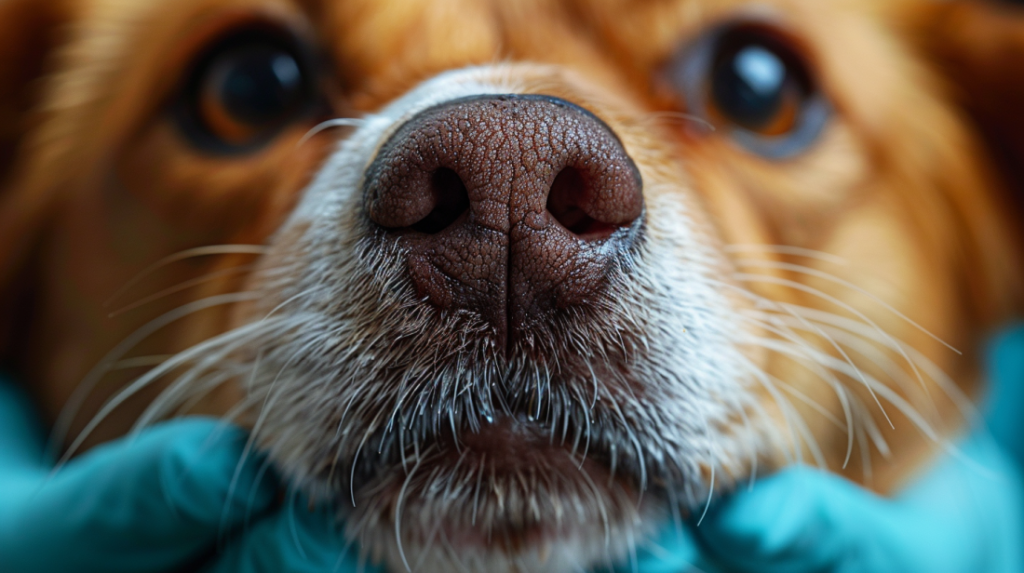Recognize canine distemper symptoms early to save your dog’s life. Learn the 6 critical warning signs, transmission methods, and prevention strategies from veterinary experts.
Table of Contents
When your beloved furry companion starts showing unusual symptoms, it’s natural to worry. Among the many health concerns that can affect dogs, canine distemper stands out as one of the most serious viral infections that every pet owner should understand. This highly contagious disease has a devastating impact on dogs worldwide, with mortality rates reaching up to 50% in adult dogs and even higher in puppies.
Canine distemper is caused by the canine distemper virus (CDV), a member of the morbillivirus family that’s closely related to the measles virus in humans. What makes this disease particularly dangerous is its ability to affect multiple organ systems simultaneously, including the respiratory, gastrointestinal, and nervous systems. The virus spreads rapidly through dog populations, especially in areas with low vaccination rates, making early recognition and prevention absolutely critical.
Understanding the warning signs of canine distemper can mean the difference between life and death for your dog. In this comprehensive guide, we’ll explore the six most important symptoms to watch for, how dogs contract this virus, and what you can do to protect your four-legged family member from this potentially fatal disease.
Understanding Canine Distemper: The Silent Killer

Canine distemper virus has earned its reputation as one of the most feared diseases in veterinary medicine. CDV is responsible for high morbidity and mortality in dogs worldwide, making it a significant threat to both domestic pets and wild carnivores. The virus doesn’t discriminate – it can affect dogs of all ages, breeds, and backgrounds, though unvaccinated puppies and senior dogs face the highest risk.
The disease progresses through several stages, often beginning with seemingly mild symptoms that can easily be mistaken for a common cold or minor illness. This deceptive nature is what makes canine distemper so dangerous. By the time severe symptoms appear, the virus has often already caused significant damage to multiple organ systems.
Key Statistics:
- Mortality rate: Up to 50% in adult dogs, higher in puppies
- Global distribution: Found worldwide in dog populations
- Seasonal pattern: Most cases occur during fall and winter months
- Cross-species transmission: Can affect over 20 species of carnivores
How Do Dogs Get Distemper?
Understanding Transmission Routes

To protect your dog effectively, it’s crucial to understand exactly how canine distemper spreads. Canine distemper is spread through direct contact or airborne exposure, much like the common cold in humans. The virus has multiple transmission pathways that make it particularly contagious and difficult to contain.
Primary Transmission Methods
Airborne Transmission: Puppies and dogs most often become infected through airborne exposure to the virus from an infected dog or wild animal. This may occur through sneezing, coughing, or barking. When an infected animal releases respiratory droplets into the air, nearby dogs can inhale these virus-containing particles.
Direct Contact: Dogs can catch it by sharing food and water bowls, grooming each other, or simply being near an infected animal. The virus can survive on surfaces for short periods, making contaminated objects another source of infection.
Bodily Fluids: It is mainly transmitted by aerosols (airborne microdroplets) or by direct and indirect contact with oral, respiratory and ocular fluids (e.g., saliva, sneezing), urine or feces of infected animals.
High-Risk Environments
Certain environments pose elevated risks for canine distemper transmission:
- Animal shelters and rescue facilities
- Pet stores and puppy mills
- Dog parks and boarding facilities
- Grooming salons and veterinary clinics
- Areas with wildlife populations (raccoons, foxes, skunks)
Dogs with incomplete vaccination histories or those from questionable backgrounds face the highest risk of exposure. The typical distemper suspect is a rescue or pet store dog or puppy, usually with questionable vaccination history or an as yet incomplete vaccination series.
The 6 Critical Signs of Canine Distemper
Early recognition can save your dog’s life
| Sign | Description | Severity | When It Appears |
|---|---|---|---|
| Respiratory Distress | Persistent coughing, difficulty breathing, nasal discharge that progresses from clear to thick and purulent | High | Early stage (1-2 weeks) |
| Gastrointestinal Issues | Severe vomiting, diarrhea (often bloody), loss of appetite, and rapid dehydration | High | Early to mid stage (1-3 weeks) |
| Neurological Symptoms | Seizures, muscle twitching, head tilting, circling, loss of coordination | High | Late stage (3-6 weeks) |
| Eye and Nose Discharge | Thick, yellow-green discharge from eyes and nose, often the first visible sign | Moderate | Very early stage (few days) |
| Fever and Lethargy | High fever (103-106°F), extreme tiredness, reluctance to move or play | High | Throughout all stages |
| Skin Changes | Thickening and hardening of foot pads and nose (“hard pad disease”) | Variable | Late stage (4-8 weeks) |
The 6 Critical Signs Your Dog Might Have Canine Distemper
Recognizing distemper symptoms in dogs early can be lifesaving. The disease typically progresses through distinct phases, with symptoms becoming more severe over time. Here are the six most important warning signs every dog owner should know:
1. Respiratory Distress and Persistent Coughing

One of the earliest and most common signs of canine distemper affects the respiratory system. Common symptoms include high fever, eye inflammation and eye/nose discharge, labored breathing and coughing. Dogs may develop a dry, hacking cough that progressively worsens, often accompanied by difficulty breathing.
What to Watch For:
- Persistent, dry cough that doesn’t improve
- Labored or rapid breathing
- Wheezing or unusual breathing sounds
- Reluctance to exercise or play
- Open-mouth breathing while at rest
The respiratory symptoms often develop into pneumonia, which can be life-threatening. Many dogs have trouble breathing and experience severe coughing. Some of these symptoms can be life-threatening and may require oxygen therapy, antibiotics, and hospitalization.
2. Distinctive Eye and Nasal Discharge

Perhaps the most characteristic sign of canine distemper is the thick, often yellow or green discharge from the eyes and nose. Symptoms include; gooey eye/nose discharge, fever, poor appetite, coughing and the development of pneumonia. This discharge is typically much thicker and more persistent than what you’d see with a simple cold.
Distinctive Features:
- Thick, sticky discharge that may be yellow, green, or gray
- Discharge that crusts around the eyes and nose
- Red, inflamed eyes (conjunctivitis)
- Discharge that returns quickly after cleaning
- Both eyes and nostrils typically affected
3. Gastrointestinal Symptoms: Vomiting and Diarrhea

The gastrointestinal phase of canine distemper can be particularly distressing for both dogs and their owners. Dogs commonly exhibit systemic clinical signs (fever, lethargy, loss of appetite), respiratory signs (nasal discharge, pneumonia), and GI signs (diarrhea). These symptoms often appear alongside or shortly after respiratory signs.
Gastrointestinal Warning Signs:
- Persistent vomiting, especially if projectile or containing blood
- Severe diarrhea, often watery and foul-smelling
- Complete loss of appetite (anorexia)
- Rapid dehydration
- Abdominal pain or tenderness
The combination of vomiting and diarrhea can quickly lead to dangerous dehydration, especially in puppies and smaller dogs. Immediate veterinary attention is crucial when these symptoms appear.
4. High Fever and Lethargy

Systemic symptoms like fever and extreme lethargy are hallmarks of canine distemper infection. The fever typically appears early in the disease process and can be one of the first signs that something is seriously wrong.
Temperature and Energy Changes:
- High fever (often 103-106°F or 39.4-41.1°C)
- Extreme lethargy and weakness
- Reluctance to move or play
- Sleeping much more than usual
- Loss of interest in favorite activities or treats
Unlike many other illnesses, the lethargy associated with canine distemper is profound and doesn’t improve with rest. Dogs may appear almost catatonic in severe cases.
5. Neurological Symptoms: The Most Serious Sign

Perhaps the most frightening aspect of canine distemper is its ability to affect the nervous system. neurologic signs (muscle twitching, focal or generalized seizures), which may be delayed can appear weeks or even months after the initial infection.
Neurological Warning Signs:
- Muscle twitching or tremors (often called “distemper jaw”)
- Seizures, ranging from mild to severe
- Loss of coordination or balance
- Circling or repetitive behaviors
- Changes in behavior or personality
- Partial or complete paralysis
Important Note: Neurological symptoms can appear even after other symptoms have resolved, making long-term monitoring essential for dogs that have survived the acute phase of the disease.
6. Hardening of Nose and Paw Pads (Hyperkeratosis)

A distinctive and often overlooked sign of canine distemper is the thickening and hardening of the nose and paw pads. It also causes gastrointestinal illness including vomiting and diarrhea, as well as thickened skin on the nose and footpads (hyperkeratosis). This condition, known as hyperkeratosis, gives the disease one of its alternative names: “hard pad disease.”
Hyperkeratosis Characteristics:
- Nose becomes dry, cracked, and unusually hard
- Paw pads thicken and develop a rough texture
- Skin may crack or develop painful fissures
- Changes are typically permanent, even after recovery
- May not appear until later stages of the disease
The Three Phases of Canine Distemper Progression
Understanding how canine distemper progresses can help pet owners recognize the disease at different stages:
Phase 1: Acute Systemic Phase (Days 1-7)
- High fever and lethargy
- Loss of appetite
- Mild respiratory symptoms
- Initial eye and nasal discharge
Phase 2: Respiratory and Gastrointestinal Phase (Days 7-14)
- Severe coughing and breathing difficulties
- Thick nasal and eye discharge
- Vomiting and diarrhea
- Dehydration and weakness
Phase 3: Neurological Phase (Weeks to Months Later)
- Muscle twitching and seizures
- Behavioral changes
- Loss of coordination
- Potential permanent neurological damage
Three Phases of Canine Distemper Progression
Understanding the disease timeline and prognosis
| Phase | Duration | Primary Symptoms | Body Systems Affected | Survival Rate | Treatment Focus |
|---|---|---|---|---|---|
| Phase 1 Initial/Acute |
1-2 weeks | Fever, lethargy, loss of appetite, eye/nose discharge, mild respiratory signs | Respiratory system, lymphatic system | 80-90% | Supportive care, fluid therapy, antibiotics for secondary infections |
| Phase 2 Systemic |
2-4 weeks | Severe vomiting, diarrhea, dehydration, pneumonia, skin thickening | Gastrointestinal, respiratory, integumentary systems | 40-60% | Intensive supportive care, IV fluids, nutritional support, respiratory support |
| Phase 3 Neurological |
3-8 weeks | Seizures, muscle twitching, paralysis, behavioral changes, coordination loss | Central nervous system, peripheral nervous system | 10-20% | Anti-seizure medications, palliative care, quality of life assessment |
Diagnosis and Treatment: What to Expect at the Veterinary Clinic
Early diagnosis of canine distemper is crucial for the best possible outcome. Veterinarians use several diagnostic methods to confirm the presence of the virus:
Diagnostic Methods:
- Physical examination and symptom assessment
- Blood tests to check for antibodies
- PCR testing to detect viral genetic material
- Chest X-rays to evaluate pneumonia
- Neurological examinations for brain involvement
Treatment Approach: Once diagnosed, care is purely supportive. Veterinarians treat the diarrhea, vomiting, and neurological symptoms, prevent dehydration, and try to prevent secondary infections.
Treatment typically includes:
- IV fluids to combat dehydration
- Antibiotics to prevent secondary bacterial infections
- Anti-seizure medications for neurological symptoms
- Nutritional support and appetite stimulants
- Respiratory support in severe cases
- Hospitalization and isolation to prevent spread
Prevention: The Power of Vaccination
Prevention remains the most effective strategy against canine distemper. The good news is that this devastating disease is entirely preventable through proper vaccination protocols.
Vaccination Schedule:
- Puppies: Start at 6-8 weeks, boosters every 3-4 weeks until 16 weeks old
- Adult dogs: Annual boosters or as recommended by veterinarian
- High-risk dogs: May need more frequent vaccination
Core Vaccine Benefits:
- Nearly 100% effective when properly administered
- Provides long-lasting immunity
- Helps create community immunity when widely used
- Safe for most dogs with minimal side effects
Special Considerations for High-Risk Dogs
Certain dogs face elevated risks and require extra attention:
Puppies Under 4 Months:
- Incomplete immune systems
- Higher mortality rates
- Need strict isolation until fully vaccinated
Senior Dogs:
- Weakened immune systems
- May need more frequent boosters
- Monitor closely for symptoms
Immunocompromised Dogs:
- Dogs on immunosuppressive medications
- Those with chronic illnesses
- Require special vaccination protocols
Prevention and Treatment Strategies
Comprehensive approach to canine distemper management
| Category | Strategy | Description | Effectiveness | Cost | Timeline |
|---|---|---|---|---|---|
| Prevention | Core Vaccination | DHPP vaccine series starting at 6-8 weeks, boosters every 3-4 weeks until 16 weeks old | 95-99% Effective | $50-150 | Lifelong protection with annual boosters |
| Prevention | Isolation Protocol | Keep unvaccinated puppies away from public areas and unknown dogs | 85-95% Effective | Free | Until fully vaccinated (16+ weeks) |
| Treatment | Supportive Care | IV fluids, nutritional support, temperature regulation, secondary infection control | Supportive Only | $500-2000 | Throughout illness (weeks to months) |
| Treatment | Antiviral Therapy | Ribavirin or interferon treatment (limited availability and effectiveness) | 30-50% Effective | $1000-3000 | Early stages only (first 1-2 weeks) |
| Treatment | Seizure Management | Anti-epileptic drugs (phenobarbital, levetiracetam) for neurological symptoms | Variable | $200-500/month | Long-term if neurological signs develop |
| Management | Environmental Disinfection | Bleach solution (1:10), UV light, proper quarantine of affected areas | 99% Effective | $20-50 | Immediate and ongoing |
| Management | Quality of Life Assessment | Regular veterinary evaluation for humane decision-making in severe cases | Palliative | $100-300 | Throughout treatment period |
Environmental Management and Prevention
Beyond vaccination, environmental management plays a crucial role in preventing canine distemper:
Home Environment:
- Regular cleaning and disinfection
- Proper ventilation in indoor spaces
- Avoiding overcrowding of pets
Public Spaces:
- Avoid high-risk areas with unvaccinated dogs
- Be cautious in areas with wildlife populations
- Choose reputable boarding and grooming facilities
Wildlife Considerations:
- Secure garbage to avoid attracting wildlife
- Don’t allow dogs to investigate deceased wildlife
- Report sick wildlife to local authorities
For more expert pet care tips and product recommendations, visit BlithePet.com — your trusted source for pet wellness.
Conclusion:
Canine distemper remains one of the most serious threats to canine health worldwide, but it’s also one of the most preventable. By understanding the six critical warning signs – respiratory distress, distinctive discharge, gastrointestinal symptoms, fever and lethargy, neurological symptoms, and hyperkeratosis – you can potentially save your dog’s life through early recognition and intervention.
The key takeaways for every dog owner are clear: maintain current vaccinations, watch for early warning signs, seek immediate veterinary care when symptoms appear, and never underestimate the importance of prevention. While treatment options exist, they are primarily supportive, making prevention through vaccination your dog’s best defense against this devastating disease.
Remember that canine distemper doesn’t just affect individual dogs – it impacts entire communities of pets. By keeping your dog properly vaccinated, you’re not only protecting your beloved companion but also contributing to the health and safety of all dogs in your community.
Stay vigilant, stay informed, and most importantly, stay up-to-date with your dog’s vaccinations. Your furry friend’s life may depend on it.
Have a similar experience with your pet? Share it in the comments below!






Leave a Reply